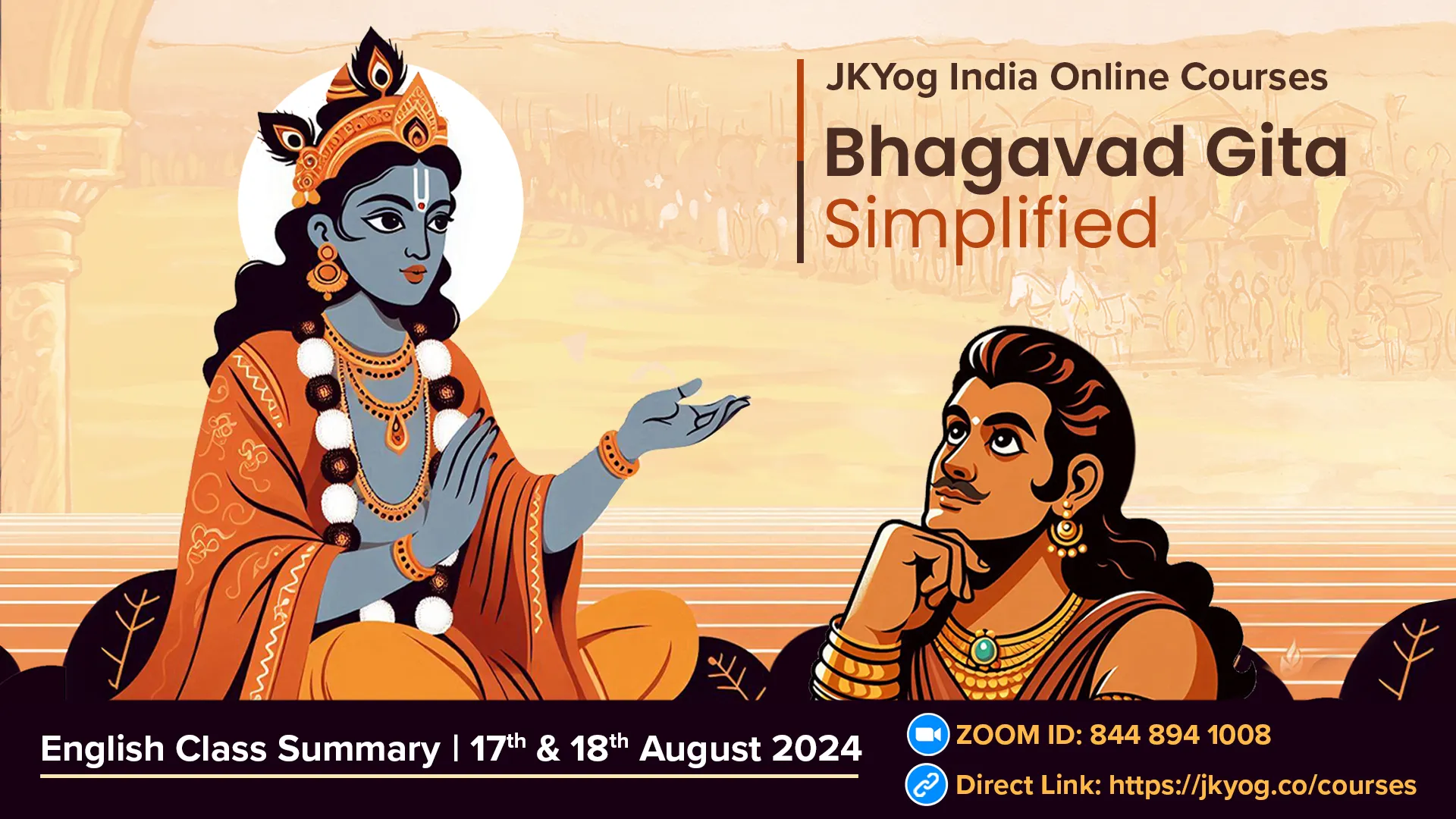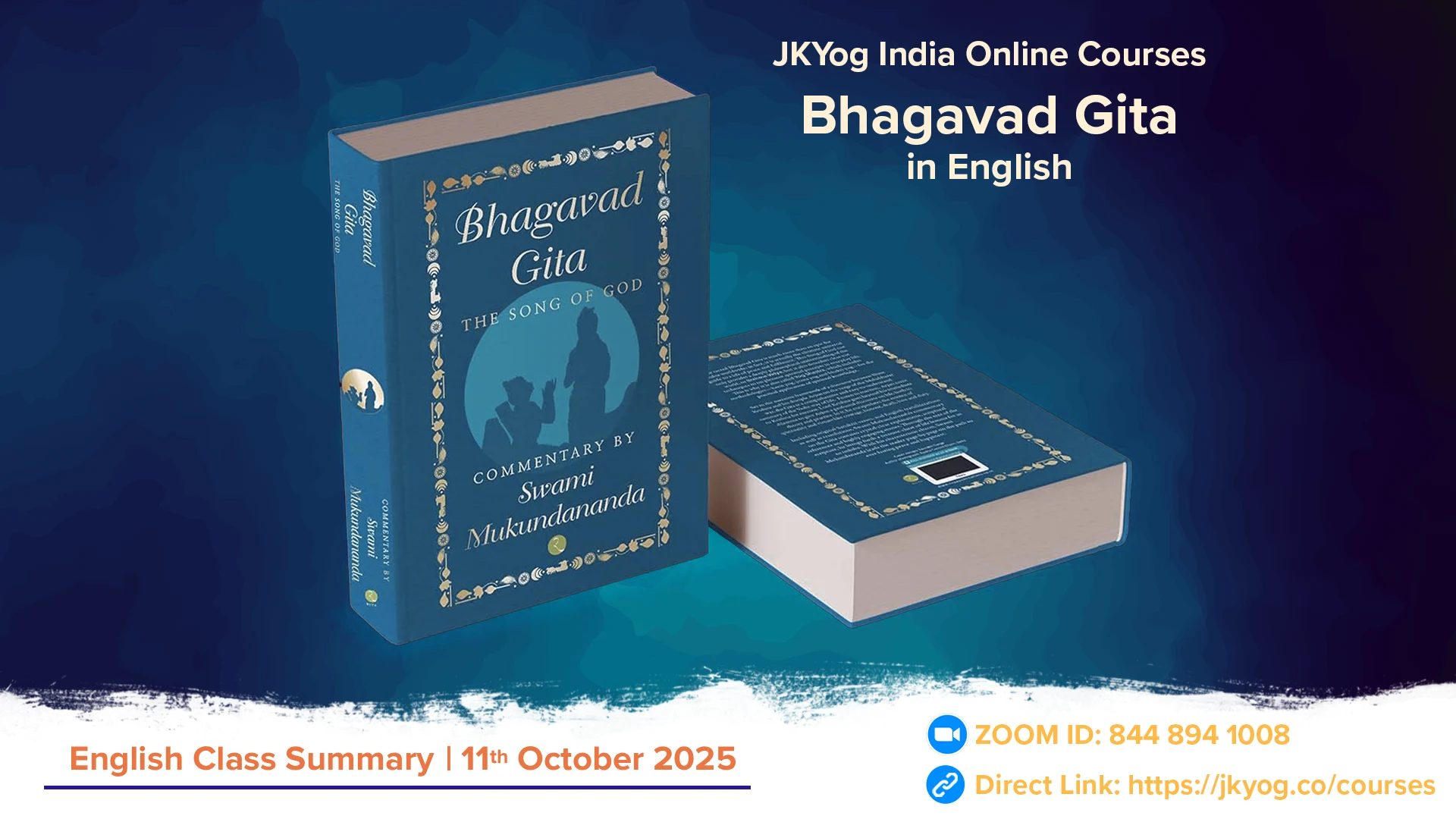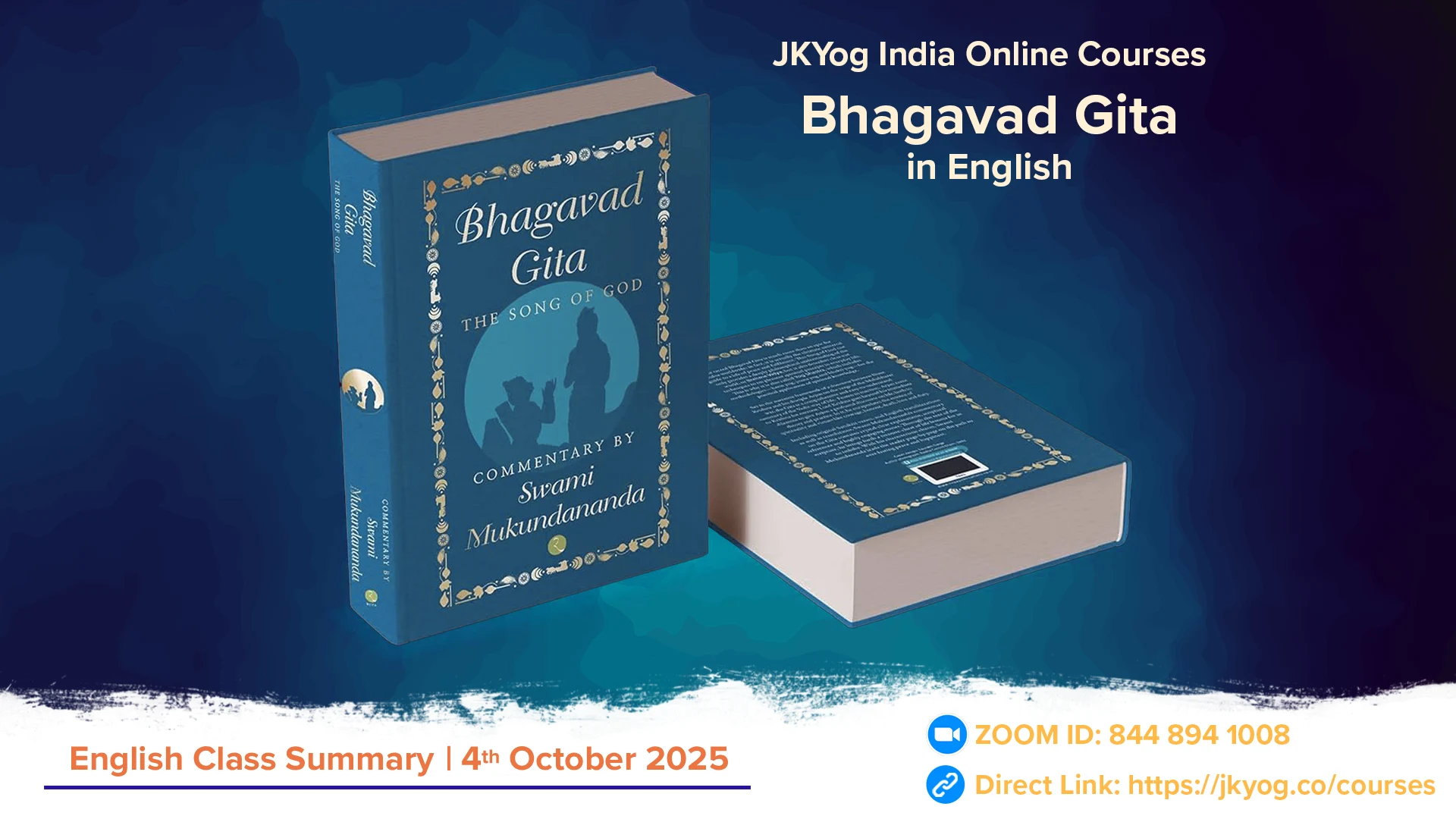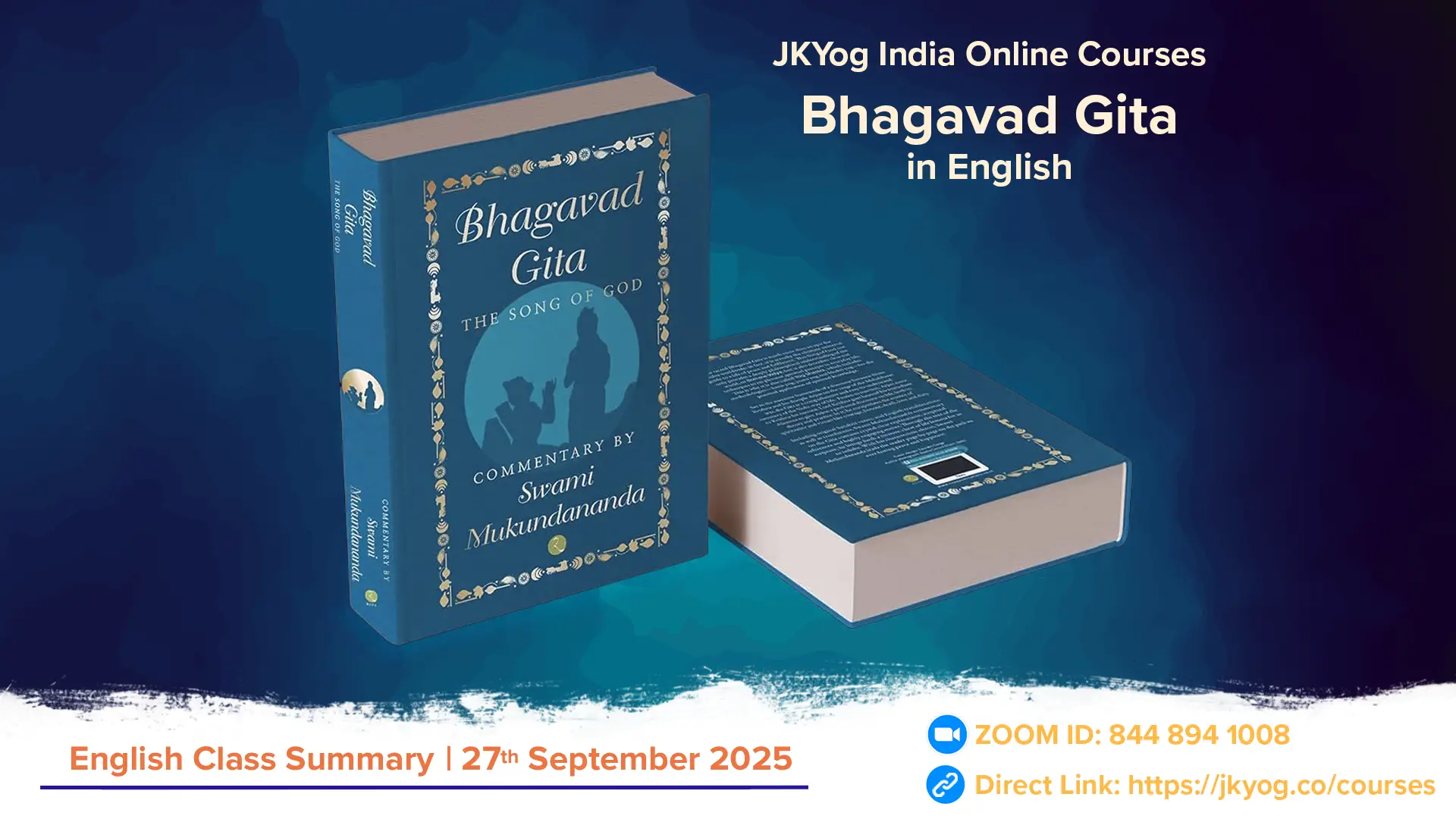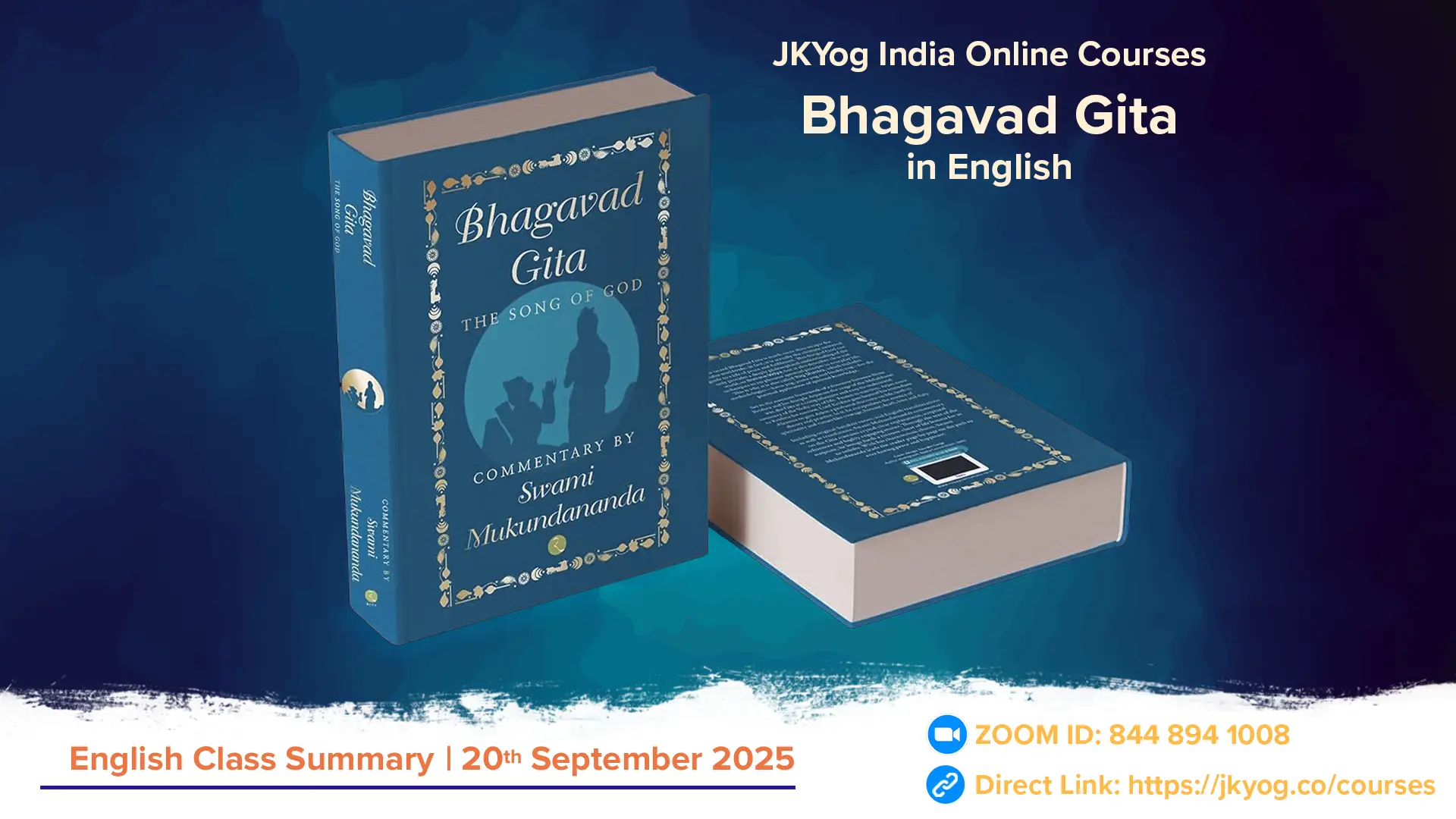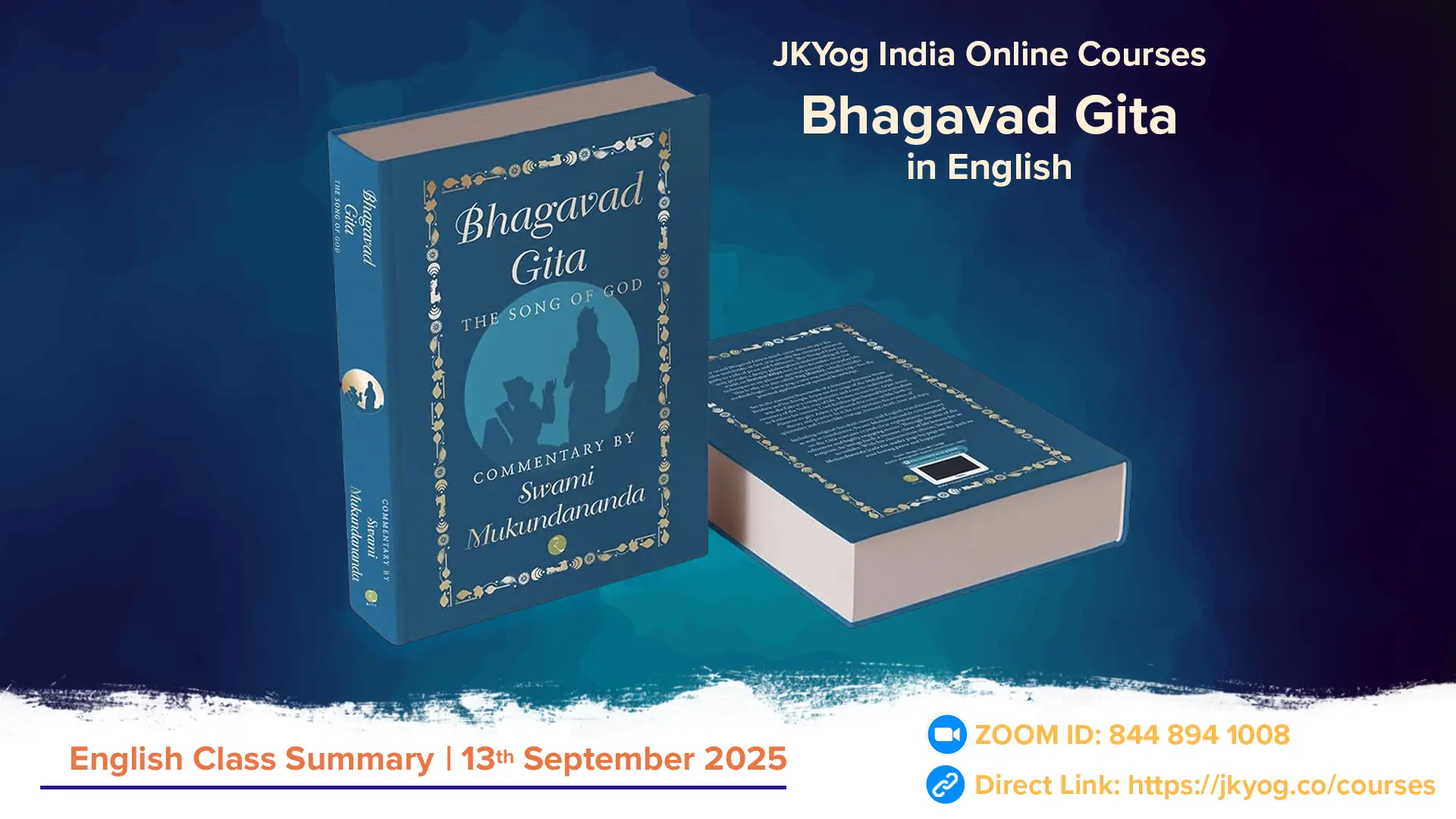In the JKYog Bhagavad Gita Simplified classes 3 and 4, we delved deeply into Arjun's profound inner conflict and his quest for guidance amidst the turmoil of the battlefield. Class 3 explored Arjun's emotional and moral dilemmas, his plea for Krishna’s wisdom, and the essential teachings on understanding our true spiritual identity. In Class 4, we expanded on Krishna's insights into Sankhya Yog, the nature of Dharma, and the principles of Karma Yog, highlighting the path to detachment and inner peace. These sessions provided timeless wisdom on navigating life's challenges, fulfilling one's duties, and achieving spiritual clarity.
Class 3- Navigating Inner Conflict: Arjun's Struggles and Krishna's Guidance
In the third session of the Bhagavad Gita Simplified course, we delve into Arjun's inner conflict on the battlefield of Kurukshetra, exploring his emotional and moral struggles and his journey toward self-realisation. Krishna's teachings become pivotal as Arjun grapples with confusion, seeking guidance on his duty and identity.
Arjun's Dilemma and Confusion
At the heart of Arjun's turmoil is the sight of his own kin, friends, and teachers on the battlefield. Overwhelmed with sorrow, fear, and attachment, Arjun is unable to summon the strength to fight despite knowing it is his duty as a warrior (Gita 1.28-1.30). This emotional conflict grows into a moral dilemma as he begins to question the righteousness of the war, fearing the destruction of family traditions and the collapse of society (Gita 1.38-1.44). Arjun's inner confusion and his struggle with attachment to his loved ones symbolise the universal human experience of being caught between duty and emotion.
Request for Guidance
In his moment of despair, Arjun turns to Krishna for guidance, expressing his inability to decide between his duty and his feelings. His heartfelt plea, "I am confused about my duty and am besieged with anxiety... Please instruct me for certain what is best for me" (Gita 2.7), marks a turning point. Once confident and heroic, Arjun admits his confusion and earnestly seeks Krishna's wisdom. This moment highlights the importance of self-reflection and the need for a guru in moments of doubt.
Key Learnings:
- Self-Reflection: Understanding one's internal conflicts is the first step toward clarity.
- Seek Guidance: Reaching out to the right source of knowledge, in Arjun's case, Krishna, is essential.
- The Role of a Guru: Arjun humbly shifts from viewing Krishna as a friend to a teacher, recognising the need for a mentor to guide him through his dilemma.
The Exploration of Our Real Identity
A major theme in Krishna's response is understanding our real identity. Arjun is not just a warrior facing an external battle but also a soul grappling with questions of existence.
Krishna helps Arjun reflect: "That which is Mine cannot be Me." We are not our possessions, relationships, or physical bodies. These are temporary and ever-changing. The body may grow, age, and eventually perish, but the soul is eternal and immutable (Gita 2.13). Through vivid metaphors, Krishna teaches that the soul is indestructible and unchangeable (Gita 2.20, 2.22). We are:
- The eternal soul.
- A part of the divine.
- Realising this spiritual identity is critical to transcending the turmoil of worldly life.
Krishna's Encouragement to Arjun: Understanding the Soul and Action
Krishna addresses Arjun's fears and doubts in multiple ways:
- Imperishable Soul: Krishna reminds Arjun that the soul is eternal and cannot be destroyed (Gita 2.23). Therefore, there is no reason to grieve for the inevitable loss of the body.
- Inevitability of Birth and Death: Even if Arjun believes that the soul undergoes birth and death, Krishna emphasises that this cycle is natural and inevitable. All living beings experience birth and death, so sorrow is unnecessary (Gita 2.26).
- Indestructible Soul: The soul cannot be harmed by weapons, fire, water, or wind. Thus, the physical death of warriors on the battlefield is not the end of their true essence (Gita 2.24).
Krishna urges Arjun to shed his cowardice and fulfil his duty as a Kshatriya. Inaction would lead to dishonour, which is worse than death (Gita 2.31-2.37).
Two Kinds of Duties: Apara and Para Dharma
Krishna introduces Arjun to the concepts of Apara Dharma (worldly duty) and Para Dharma (spiritual duty). As a Kshatriya, Arjun's Apara Dharma is to fight in a righteous battle. Fulfilling this duty, Krishna assures, will bring either victory on earth or a place in the celestial realms. But Krishna then elevates the discussion, guiding Arjun toward Para Dharma—the path of self-realisation and liberation from the cycle of birth and death.
The Science of Action: Karma Without Attachment
Krishna teaches Arjun the more profound principles of Karma Yog—the science of action without attachment to its results. Arjun fears incurring sin by killing his enemies, but Krishna explains that actions performed with detachment do not bind the soul to karma. By relinquishing attachment to the fruits of his actions, Arjun can fulfil his duty without accruing sin.
Krishna introduces Buddhi Yog, or the "Yog of the Intellect," which involves using the intellect to detach from the fruits of one's actions and to develop resolute decision-making. Practising discrimination with the intellect allows one to act in harmony with divine will, free from the bondage of karma.
Conclusion of Class 3
In this class, we explored Arjun's profound journey from confusion and despair to clarity and action. Through Krishna's teachings, Arjun begins to understand the nature of the soul, the importance of fulfilling his duty, and the wisdom of detaching from the results of his actions. This session offers timeless spiritual guidance and practical lessons on navigating our own dilemmas, identifying our true selves, and fulfilling our duties with courage and detachment.
Class 4: Sankhya Yog and Karma Yog: Navigating Duties and Cultivating Detachment
In this fourth session of the Bhagavad Gita Simplified, we delve deeper into Arjun's quest for guidance as he turns to Krishna to resolve his inner turmoil. Krishna imparts profound wisdom through Sankhya Yog, the analytical knowledge of the eternal soul, and offers insights on how to act without being bound by the consequences.
Arjun's Search for Guidance and Sankhya Yog
Arjun, unsure of how to proceed, seeks Krishna's wisdom. In response, Krishna introduces the concept of Sankhya Yog—the analytical knowledge of the eternal soul. Krishna begins by emphasising a core truth: We are not the material body but the eternal soul. This understanding is crucial to navigating life's challenges with detachment and clarity.
The Dual Nature of Dharma
Krishna explains that we have two types of dharma:
- Physical (Apara) Dharma: This pertains to our worldly duties.
- Spiritual (Para) Dharma: This relates to our higher purpose of God-realization and spiritual elevation.
Each of these dharmas must be understood and practised to live a life of balance and harmony.
The Physical Duties and Modes of Nature
In the physical realm, duties are performed under the influence of three modes of nature:
- Mode of Goodness (Satva) – Leading to heaven.
- Mode of Passion (Rajas) – Leading to earthly pleasures and attachments.
- Mode of Ignorance (Tamas) – Leading to hellish conditions and suffering.
However, Krishna warns that every action creates bondage regardless of the mode. Thus, the key question arises: How can we perform our duties without becoming bound by the results?
The Science of Action: Karma Yog
Krishna provides the answer through the Science of Action (Karma Yog):
कर्मण्येवाधिकारस्ते मा फलेषु कदाचन। मा कर्मफलहेतुर्भूर्मा ते सङ्गोऽस्त्वकर्मणि॥ (Gita 2.47)
"You have a right to perform your prescribed duties but are not entitled to the fruits of your actions. Do not consider yourself the cause of the results, nor be attached to inaction."
Krishna teaches Arjun that while we must perform our duties, we should not concern ourselves with the results. The fruits of our actions are not for our enjoyment, and pride in doership should be abandoned. This detachment from outcomes leads to liberation from karmic bondage.
The Human Form: A Rare Opportunity
Krishna emphasises the rarity and value of human life. The Vedas explain that human birth is an extraordinary opportunity for spiritual progress. If we do not strive for God-realisation in this life, we risk falling back into the cycle of birth and death across the 8.4 million species of life.
- Misuse of Human Life: It is a waste to use human life solely for worldly pleasures like eating, sleeping, mating, and defending. Krishna reminds Arjun that animals are better suited for such activities. For instance, a pig's body is better designed for indulgence in food, and a polar bear's body is ideal for long periods of sleep.
Even if we do not achieve spiritual perfection in this life, God preserves our spiritual progress. Our efforts are never lost, and we can continue from where we left off in the next birth.
Attachment and the Mind
Krishna explains the reason for attachment: the body and mind are material, naturally drawn to worldly pleasures. However, the soul is divine and seeks eternal bliss in the Supreme. This misplaced identity—thinking that fulfilling bodily desires will satisfy the soul—creates a cycle of desire and dissatisfaction.
Krishna outlines the Cycle of Attachment:
- Contemplation: Focusing on sense objects creates attachment.
- Attachment: Leads to desire.
- Desire: When fulfilled, it leads to greed; when unfulfilled, it leads to anger.
"While contemplating the objects of the senses, one develops attachment. From attachment, desire arises; and from desire, anger manifests." (Gita 2.62)
This cycle binds the mind and keeps it restless, hindering spiritual success.
The Consequences of Attachment: A Path to Suffering
Krishna explains that attachment leads to suffering:
- Entanglement: The constant desire for fulfilment creates instability in the mind. Once a desire is satisfied, the mind immediately seeks out new desires.
- Hindrance to Spiritual Success: Those attached to worldly pleasures are unable to develop the determination required for success on the spiritual path (Gita 2.44).
One cannot attain peace or happiness without discipline and control over the mind and senses. Krishna compares the uncontrolled mind to a boat swept off course by the wind: "Even one of the senses on which the mind focuses can lead the intellect astray" (Gita 2.67).
Detachment: The Path to Inner Peace
Krishna encourages Arjun to cultivate detachment to attain peace and freedom from suffering:
- Inner Peace: A person who gives up material desires and egoism attains perfect peace (Gita 2.71).
- Free from Entanglement: By practising Karma Yog—performing work without attachment—one can rid oneself of both good and bad reactions, achieving freedom from karmic bondage (Gita 2.50).
The ultimate goal is to attain a state beyond all suffering by abandoning attachment to the fruits of actions and cultivating equanimity of intellect. This state leads to spiritual liberation and freedom from the cycle of birth and death (Gita 2.51).
Conclusion of Class 4
In this class, Krishna's teachings provide a blueprint for navigating life with clarity and purpose. We can perform our duties without creating bondage by understanding our true identity as the eternal soul and practising detachment from worldly desires and outcomes. Through the Science of Action (Karma Yog), Krishna guides us on a path of self-realisation, offering freedom from suffering and attachment. The journey of detachment leads to inner peace, spiritual growth, and ultimately, the fulfilment of our Para Dharma—our spiritual duty.
Summary: JKYog India Online Class- Bhagavad Gita Simplified [English]- 17th and 18th August 2024

